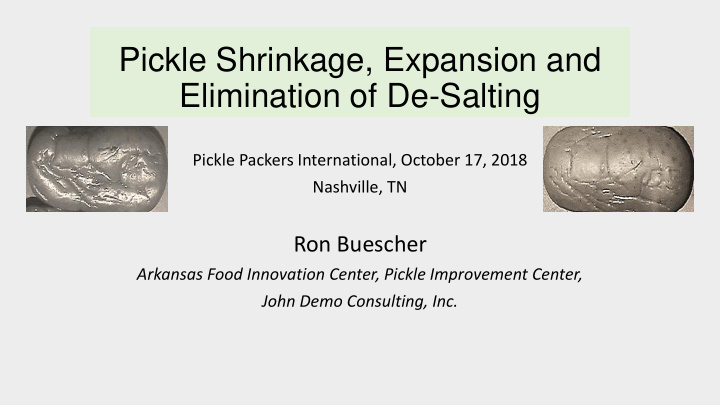



Pickle Shrinkage, Expansion and Elimination of De-Salting Pickle Packers International, October 17, 2018 Nashville, TN Ron Buescher Arkansas Food Innovation Center, Pickle Improvement Center, John Demo Consulting, Inc.
Presentation Subjects • Why do cucumbers shrink in brine? • Factors affecting shrink: (weight, volume) • Reversible shrinkage • Restrictions to expansion • Damages that cause irreversible shrinkage • Elimination of de-salting
Shrinkage is caused by dehydration- loss of water from cells and cell walls Membranes destroyed Irreversible- Brine Enters, Membranes Destroyed, Cells are Killed; Slightly Shrivelled Cell Walls and Middle Lamella are Entirely Responsible for Pickle Structure. Brine causes water to move out of cucumber cells by osmosis. When cell membranes are destroyed movement of substances in and out of cells is by diffusion.
Effect of brining on cucumber cell membranes and contents Membranes destroyed Fresh Plasmolysis, loss of turgidity Cell wall Protoplasm
Cell walls (X 4500) of cucumbers before and after brining: note wrinkles and shriveling caused by exposure to fermentation brine = dehydration. Before After
Cucumber respiration rapidly increases when submerged in fermentation brine, then it gradually declines as membranes rupture. Days in Brine
General pattern of shrinkage of cucumber (3A) weight and volume caused by brine (initially 14% salt that equilibrated to 6%, (Cathy Hamilton) 12 wt 10 vol % 8 Loss 6 4 2 0 0 10 20 30 40 50 60 Days after brining
Effect of NaCl concentration on shrinkage and expansion of 3A cucumbers ( Jeff Ross) Avg. of 50 individually measured fruits; cucumbers initially placed in 26% NaCl 25 wt 21.0 20 vol. 18.0 % 15 Loss 11.0 10 6.0 8.5 4.5 5 3.0 2.5 4.0 3.0 1.7 2.0 0 0 2 4 6 8 10 12 Equilibrated NaCl (%)
Reversibility of Shrinkage 13% NaCl (26 13%) Desalted to 1% NaCl
Calcium hinders expansion of processed pickles ( Jeff Ross) NaCl adjusted to provide ionic strength equal to 6.5% NaCl of brine stock 10 wt 8.8 9 8.6 7.8 8 vol 7 % Loss 6 5.5 5.4 5.3 5 4.2 4 3.5 3.2 3 2.5 2.4 2.3 2.2 1.8 2 1 1 0.7 1 0.5 0 0 0.35 0.7 0 0.35 0.7 0 0.35 0.7 Brine Stock De-salted (3.2%) Packed (2.5% NaCl) % CaCl 2 in Fermentation Brine (3A cucumbers)
Alum added during de-salting reduces pickle expansion: wt and vol increases after processing; Al+++ reduces amount of gain (Jeff Ross) . 12 No alum Alum (0.16% Al sulfate) 9.8 9.8 10 9 8.4 8.4 8.4 8 8 7.7 8 7.4 7.4 6.5 6.5 6.5 6.2 5.7 6 % Gain 4 2 0 0 4 12 24 0 4 12 24 vol wt (0 = salt stock gain after de-salting; 4, 12, 24 are weeks in process brine)
Irreversible shrinkage: Physical damage (internal) reduces the ability of pickles to plump. • Drops, bumps, collisions, compressions • Dr. Dale Marshall (1976) demonstrated that drops of 2.5 ft or many low- magnitude drops increased the frequency of internal fractures and increased lens and balloon bloating. • Compression against head boards caused by buoyancy pressure: no damage caused by hydrostatic pressure • Dr. Henry Fleming et al. (1977) effect of brine depth on physical properties • Flexible restraining covers for tanks were demonstrated to be an alternative to rigid hold down materials. • Drs. Humphries, Fleming (1991), needed about 10 inches of water or brine to counter buoyancy force • Handling of brine stock- unloading tanks, transport, process tanks, finish processing many more drops, bumps, collisions, compressions
Model of Buoyancy Force as Affected by Tank Height and Difference in Density Between Cucumbers and Brine: John Demo, John Demo Consulting
Hidden green stock damages that affect shrinkage/plumping; No evidence of interior damage from exterior. Split carpel and crushed endocarp Bruised ends Fractured end Crushed endocarp
Internal damage adversely affects expansion during processing; damage may occur during all operations
Summary: Pickle Shrinkage and Expansion • Shrinkage of volume is greater than shrinkage of weight (6% salt solution weighs 4.1% more than water). • Density= mass (wt)/volume increases (~0.945 to 1.045). • Shrinkage and expansion are dependent on salt concentration. • Calcium in fermentation brine reduces expansion during processing. • Alum added during de-salting reduces expansion during and after processing. • NaCl induced shrinkage is generally reversible (less than 3% after processing); however, shrinkage of physically injured pickles is irreversible.
Waste-salt-water reduction • Option 1: Use pickles without de-salting. Why can’t pickles be used without de-salting? • Calcium chloride in fermentation brine allowed substantial reduction of NaCl to maintain brine stock quality along with reduced de-salting (1978-79). • Option 2: Use de-salt water in finished products such as fresh pack. Why can’t de -salt water be used?
A Few Examples of No De-salting and Use of Spent Brine • Genuine dills- used to be the most favored pickle • Bubbies Pickles- brine contains lactic acid bacteria • Bag in Box Fermentation and Storage • Pickle Pak Science 2002 • Henry Fleming, Humphries, McFeeters- Process ready; consumer ready • Suzanne Johanningsmeier, Thompson, Fleming- • Favorable flavor, no objections to lactic acid taste of bag-in-box fermented pickles • Also, spent brine was used as process brine for fresh pack pickles and the sensory panel liked the flavor/taste as well as pickles acidified with vinegar.
Reasons Given for De-salting • Traditional procedure to reduce excessive amount of salt • Reduce tank flavors/tastes (“Tanking”) • Customers don’t like lactic acid taste • Plumping of salt stock • Process for adding alum • Others reasons??
Potential methods to use spent or de-salt brines for process brine • Use clean cucumbers and/or clean fermentation/storage environment such as Bag-in-Box or sauerkraut tanks. • Filtration of spent salt stock brines or de-salt brines: remove insoluble and flavor substances. • Activated charcoal or other absorbents of flavor/taste substances • Ultrafiltration • Heat and sparge brines to remove volatiles • Others??
Spent fermentation brine before and after filtering Filtered Tank Brine Tank Brine
Comments? Questions?
Recommend
More recommend